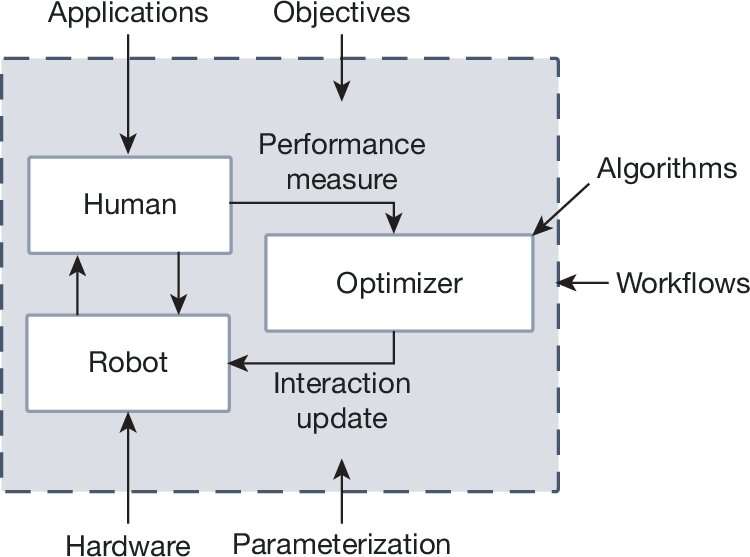
October 14, 2024 by Matt Goisman, Harvard John A. Paulson School of Engineering and Applied Sciences
Collected at: https://techxplore.com/news/2024-10-tout-effectiveness-individual-optimization-algorithms.html
A patient recovering from a limb amputation won’t use a prostheses that isn’t comfortable. A person rehabbing from a stroke won’t use a robotic exoskeleton if the mobility it grants doesn’t allow them to perform everyday activities. And a diabetes patient won’t use an insulin pump that doesn’t deliver the appropriate dosage of medicine to control their blood sugar.
All of these challenges fall under a concept known as “human–robot interaction,” a critical issue in robotic design and engineering. A new perspective from researchers at the Harvard John A. Paulson School of Engineering and Applied Sciences (SEAS) delves into a potential approach to improve human–robot interaction.
The approach, known as “human-in-the-loop optimization” (HILO), explores the potential of combining individual patient data with machine learning algorithms as a way to fine-tune robotic design and improve results for specific performance metrics.
Patrick Slade, Assistant Professor of Bioengineering at SEAS, was first author on the Perspective, which was published in Nature.
“I hope this perspective can accelerate the development and effectiveness of human–robot interactions when developing robotic systems, especially for medical applications where these systems interact with people,” Slade said.
“I’m hopeful that this perspective will encourage researchers to think about humans as complex, challenging systems to design for. HILO can be a tool to maximize the effectiveness of devices that interact with people.”
The idea of human-in-the-loop optimization has been around for about seven years, Slade said, but has yet to be fully adopted into the robotic engineering space. Because every human is different, human–robot interaction is a very difficult concept to predict and design for, which can slow down innovation in the field.
“Working with these populations and devices for a while, I’ve seen that when people are introduced to a new device, their conceptions of the device, what they want and how they might use it, change as they get used to it,” he said.
“It’s a moving target with dual challenges, where you need them to understand and adapt with the device, and you also want to provide them with something that provides a benefit to the user and is acceptable for regular use.
“HILO can help inform what the human–robot interaction should be to improve whatever human–robot metric is important to that population. Knowing what effective human–robot interaction is needed, for example, what torque to provide with an ankle exoskeleton to help people post-stroke to walk more quickly and efficiently, can inform the development of effective devices.
“HILO can also maximize performance of an existing commercial device by systematically tuning how that device interacts with the user. We’ve seen an optimized assistance double the benefits compared to a generic controller for an ankle exoskeleton device, showing HILO can have a big impact on patient outcomes without even changing the device hardware.”
Though called an optimization algorithm, Slade described it as closer to a “personalization” algorithm, in that it uses personal data to optimize the device to the individual patient. And because it’s based on machine learning algorithms, the optimal adjustments can be found quickly and without an engineer needing to pour through multiple potential designs.
“One challenge in the field of robotics is that people often get treated as robots,” Slade said. “People are complex and often don’t respond to robotic assistance in a predictable way. This paper is posing the idea that a lot of our research intuitions on human–robot interaction aren’t great because people are very complex.
“If we admit that, we can use this systematic approach to optimize assistance and really accelerate the field. Adopting HILO would really accelerate the field, and patients would see more benefits.”
Slade envisions HILO as especially valuable in the earliest design stages, when research is still being done in labs as opposed to field testing finished or nearly finished designs. During those early stages, engineers typically test out numerous different designs and functions to try to home in on one that meets whatever they determine to be the most important performance metrics.
Examples of metrics in medical devices, for example, include muscle contraction, fatigue, walking speed, heart rate, blood glucose levels, or other measures of improved mobility.
Using HILO algorithms, designers could quickly determine if a design needs to be adjusted based on individual patient data to maximize its benefit.
“HILO allows you to identify the meaningful interactions, then build a portable device based on what you’ve learned,” he said. “Rather than building multiple interactions of a portable device, you could do it in a single shot, which could help accelerate the field.”
Conversely, Slade’s perspective suggests even late-stage design or products already on the market could still benefit from these optimization algorithms. HILO is similar to getting a glasses prescription, systematically tuning the human–robot interaction to achieve a desired outcome, similar to a new prescription.
“You have a device, you optimize the controller, and now you have a more personalized controller and see better benefits,” he said. “We’ve seen from a few studies that existing portable devices can double their performance if you apply HILO.
“It’s the same hardware—you just update the controller, and all of a sudden your device is twice as effective. That’s exciting. You could spend years developing something, and then all of a sudden double the performance just by systematically tuning the human–robot interaction.”
More information: Patrick Slade et al, On human-in-the-loop optimization of human–robot interaction, Nature (2024). DOI: 10.1038/s41586-024-07697-2
Journal information: Nature

Leave a Reply